Today I have a great arctic animals word search to share as a winter tool to develop visual perceptual skills, handwriting, attention, and executive functioning skills, all with an arctic theme. This printable arctic animals worksheet is a fun winter therapy theme in occupational therapy that you can use all season long. You’ll also want to check out our winter fine motor activities which includes hands-on activities and free winter worksheets to support underlying areas of development.

Arctic Animals Word Search
We created this arctic animal word search to use in therapy with a winter theme, while building skills. During the cold months, an arctic animal theme is a common one!
This arctic animal word search includes words such as:
- narwhal
- puffins
- reindeer
- arctic fox
- seals
This worksheet, provided to you in pdf format, can either be the jumping off point to talking about arctic animals, or the wrap up after learning about all of these amazing creatures.
The narwhal is the “unicorn of the sea”. Maybe that is what makes them so popular. Their spiraled tusks can reach up to nine feet in length. Presumed (by me) to be a fictional animal like the unicorn, or an extinct creature such as the dinosaurs. These are neither fictional, nor extinct, but an animal that is loved by many children, making it a motivating theme in occupational therapy goal achievement.
Puffins, reindeer, arctic fox, and seals are just delightful. Even the most deadly arctic animals seem cuddly from afar. Unless you are headed on an expedition to Antarctica, the only place you might spot these is the zoo, or online unfortunately.
Now that winter is fully upon us, this is a great time to use a winter theme for your lesson plans. Whether you live somewhere freezing with nine foot snow drifts, or in the south where it was 75 degrees on Christmas Day, this is a cool theme.
Learners who live in the snow can personally relate to this winter theme, while those in warmer climates have to research and imagine the cold.
The OT Toolbox has great worksheets and resources to cover your treatment planning needs!
That’s where this free winter word search comes into play.
Before jumping into the “what and why” of word searches, let’s talk strategy! When completing puzzles and word searches, are you type 1 who just dives right in and searches in a random fashion, or type 2 who has a systematic way of proceeding?
One tip for scanning for words is to earch row by row across the lines looking for the first letter in the word. When that letter is found, look in all directions around the letter for the second letter in the word. Work sequentially to scan for each letter in the word search this way.
One benefit to scanning for words systemically is that you are not only targeting an important visual processing skill (visual scanning and saccadic eye movements) but you are working through the task in an organized manner. This is effective for addressing visual attention needs, as well as the executive functioning skill of task completion.
As a firm type 2, it seems this is the correct way to go about completing puzzles and word searches. I teach these types of strategies when working on visual motor or perceptual tasks. It may not be as exciting, but it is efficient and effective.
Use an Arctic Animal Word Search in Occupational Therapy
Occupational therapy practitioners use word searches to target several areas of development. Let’s break it down:
Why do we do word searches? Is it for fun, personal achievement, or because it is required? Possibly all of the above, however, worksheets like this Arctic Animal Word Search build necessary visual perceptual skills.
What skills are being addressed?
Visual Perception: There are seven categories of visual perception. Which ones do you think are being used in this winter animal word search activity?
- Visual memory – remembering what was seen long enough to find it somewhere else
- Visual scanning – being able to look at all of the choices (either in random or sequential order)
- Visual form constancy – looking at items that might be slightly different or in a different position and recognizing they are the same figure
- Visual figure ground – picking out items from competing backgrounds
- Visual spatial relations – identify items in relation to other items. What is in front, next to, behind
- Visual closure – making sense of an item when only given part of it, such as doing a puzzle
- Visual discrimination – the ability to idenfity differences between objects which may be obvious or subtle
If you responded, all of the above, you are correct! Imagine the amount of visual skills, attention, concentration, brain power, and motivation it takes to incorporate all of these skills at the same time?
Visual perception is more than just arctic animal worksheets. It is a much needed skill for self care, activities of daily living, reading, writing, and simply navigating one’s environment. Work pages are a controlled systematic format to build these skills.
Make this arctic animal worksheet part of your bigger treatment plan. Your plan could be a winter theme, animals, visual perception, or any combination of the above. The OT Toolbox has tons of new and archived resources for visual perceptual activities and ideas, including this animal themed visual perception activity in a slide deck task.
Besides visual perception, what other skills are being addressed using this Winter word search ?
- Fine motor – By completing the arctic animal word search, address: grasping pattern, wrist stability, intrinsic hand muscle development, pencil control
- Bilateral coordination – Holding the paper while writing on the word search, use hand dominance, using “helper hand”, crossing midline
- Proprioception – Address sensory input such as pressure on paper, grip on writing tool
- Strength – Target strengthening by using the arctic animal wordsearch with shoulder, elbow, wrist, hand, core, head control
- Executive function- Target specific skills by completing the printable word search including: following directions, attention, focus, sequencing, planning, task completion, frustration tolerance
- Social function – Use this word search in OT sessions by working together in a group, problem solving, sharing materials and space, turn taking, talking about the activity
How do I grade this free winter word search activity? (in a clinical setting “grade” means to adapt or modify)
- Laminate the page for using markers and wipes. This can be useful for reusability as well as the enjoyment markers bring.
- Different colored paper may make it more or less challenging for your learner
- Enlarging the font may be necessary to beginning learners who have difficulty scanning
- Review skills first such as scanning, decoding, and usable strategies if you need to make the task easier.
- Project this page onto a smart board for students to come to the board and write in big letters.
- Higher level learners can write sentences with these words on the back of the page for more practice, or draw these items on a paper.
- More or less prompting may be needed to grade the activity to make it easier or harder.
- Try different writing utensils. This can be very motivating. Some learners work better with markers, as they glide easier on paper. Dot or bingo markers are super fun to use. Did you know that golf sized pencils promote more of a tripod grasp than traditional long pencils?
- Use different colored paper for more or less visual contrast.
- Have learners write a sentence using each unscrambled word.
- Draw pictures of each of the words or create a picture containing all of the words.
How to document this winter word search PDF activity:
- First determine what goals and skills you are addressing. Are you looking strictly at visual perception, visual motor skills, or something else entirely such as executive function and behavior?
- Focus your observations on the skills you are addressing. It is alright to address one or ten skills at once, just be sure to watch for those skills during the activity. This can take practice to watch everything all at once. Newer clinicians often videotape sessions to go back and review clinical observations they may have missed.
- Use data to back up your documentation. Avoid or limit phrases such as min assist, fair, good, some, many, etc. They are vague and do not contain the numbers and data critical to proficient documentation. Instead use percentages, number of trials, number of errors, number of prompts, minutes of attention, or behavioral reactions.
- This type of documentation may feel foreign at first if this is not what you are used to, however insurance and governing agencies are becoming more strict on accurate documentation.
free winter word search
Want a free printable arctic animal word search? Enter your email address into the form below. You can also access this printable winter word search inside the Member’s Club. Level 1 members will find it in our Vision Membership Tools and Level 2 members will find the resource there as well as in our Arctic Animals Therapy Theme.
Or, enter your email address into the form below for immediate access:
What’s next? The OT Toolbox has a wonderful Winter Fine Motor Kit packed with activities and ideas, including arctic animal pencil control pages, cutting and snipping worksheets, pinch and grip activities and tons more!

Victoria Wood, OTR/L is a contributor to The OT Toolbox and has been providing Occupational Therapy treatment in pediatrics for more than 25 years. She has practiced in hospital settings (inpatient, outpatient, NICU, PICU), school systems, and outpatient clinics in several states. She has treated hundreds of children with various sensory processing dysfunction in the areas of behavior, gross/fine motor skills, social skills and self-care. Ms. Wood has also been a featured speaker at seminars, webinars, and school staff development training. She is the author of Seeing your Home and Community with Sensory Eyes.



